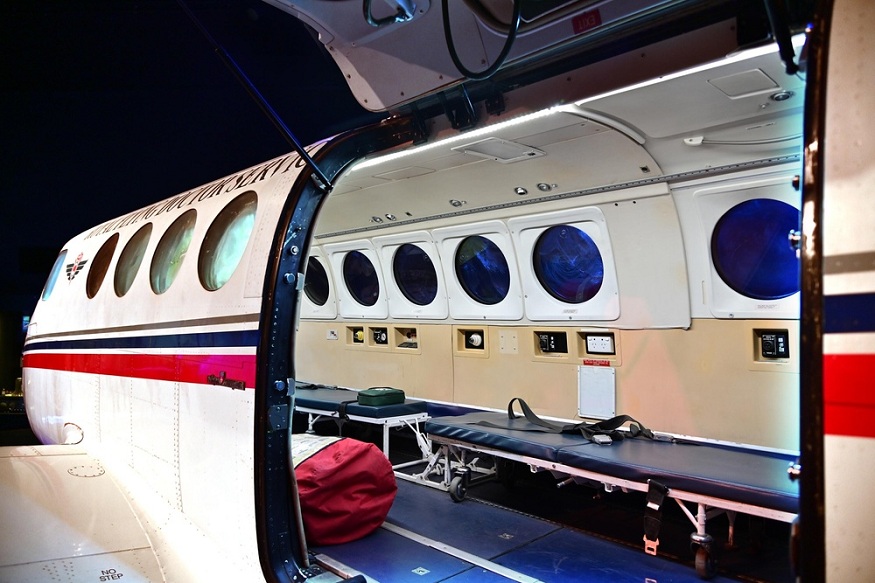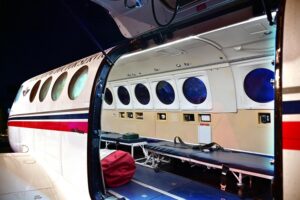Mission Critical: How Aerospace Advancements Strengthen Emergency Airlifts
3 min read
DUBBO, NSW - MAR 07 2023:Royal Flying Doctor Service plane cabin providing health care and 24-hour emergency service to people who live, work and travel across the 8 million km² of Australia.
Airplanes and helicopters are essential aerial links in times of crisis. Emergency airlifts quickly transport people. They save numerous lives annually. How are these rescues made possible? The solution is found in advanced aerospace technology that continually improves annually.
Faster Response Times Save Lives
Speed is deadly, but in emergency medicine, insufficient speed is deadlier. Contemporary airplanes can now arrive at accident sites in half the time it required merely two decades ago. Their upgraded designs allow for increased power. It also has greater fuel efficiency. This allows helicopters to fly farther. It enables them to travel longer distances with no need to refuel.
GPS technology has transformed how pilots navigate. It has given them the power to identify destinations with amazing precision. The days of being confused by bad weather or unfamiliar territory long gone. Modern navigation systems direct aircraft precisely to landing areas. Some systems also recommend the safest routes for flying around storms and other hazards.
Weather No Longer Grounds Rescue Missions
Remember when fog or rain forced rescue helicopters to remain grounded? Those days are mostly over. Pilots use modern radar technology to see beyond clouds and fog. They even see through the cover of darkness. Night vision transforms darkness into daylight for rescuers.
Anti-icing technology allows planes to fly safely. Even when there’s ice. Rotor blades with special coatings help to prevent ice from forming. Once upon a time, this used to make winter rescues nearly impossible. These improvements guarantee that help can get to those who need it. It doesn’t matter what challenges nature presents to emergency workers.
Better Equipment Means Better Care
The interior of a contemporary air ambulance resembles a flying hospital rather than just a basic transport vehicle. Lightweight materials enhance the strength of aircraft. They also decrease their weight. This additional space accommodates life-saving medical equipment. Equipment that couldn’t be transported previously.
According to the people at LifePort, miniaturized electronics have reduced intricate medical devices to compact dimensions. Heart monitors, breathing machines, and various medevac equipment now occupy only a small portion of the space they previously needed. Physicians can conduct operations mid-flight that were once restricted to hospital emergency departments.
Satellite communication maintains the link between medical teams and hospitals while in flight. This immediate consultation frequently determines the line between life and death.
Safer Flights Protect Everyone
No one wishes to cause additional victims while attempting a rescue. Modern airplanes feature several backup systems for essential parts. If a system fails, another one automatically assumes control. Engine issues that once guaranteed crashes now hardly disrupt the flight.
Enhanced pilot training employs virtual reality simulators that generate highly realistic emergency situations. Pilots train for every potential emergency without endangering real lives. This training becomes evident during real emergencies as pilots react more quickly and make improved choices when under pressure.
More durable aircraft materials safeguard crews and patients during rough landings or emergencies. Crash-proof fuel systems avert fires that used to turn minor accidents into fatal ones. These safety enhancements provide all individuals on board a greater opportunity to survive unforeseen circumstances.
Conclusion
Emergency airlifts will improve further as technology progresses. Electric planes mean quieter travel, even during late-night emergencies. Artificial intelligence might soon help pilots make quick decisions when they are in dangerous situations. Drone technology might be able to aid human pilots in delivering medical supplies for certain needs. Transplant organs, essential medications, and blood donations could reach distant locations sooner. The partnership between aerospace engineering and emergency medical services is flourishing. Each technological breakthrough contributes to the preservation of life and the stability of families. When emergencies arise, these aerial guardians are ready to act, offering a faster, safer, and more skilled response than before.





